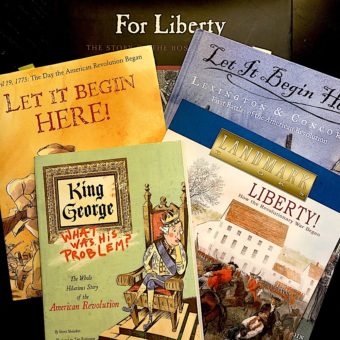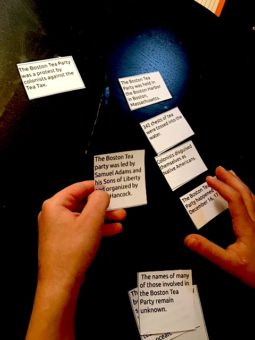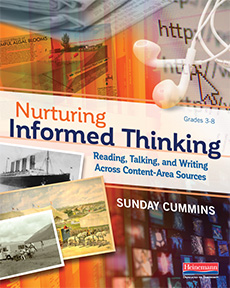Students Making Sense of Multiple Sources
By Martha Polley and Sunday Cummins

Martha
When your students read, view, and listen to multiple sources on a topic or issue, do they tackle each source in a silo? Learning a little bit about this and a little bit about that but not really synthesizing the information from multiple sources?

Sunday
Students may not realize they need to think across sources in order to deepen their understanding of an issue. They may not realize they need to monitor for synthesis by asking questions like “What new information am I learning?” and “How does this information compare or contrast with what I learned in previous sources?”
It’s critical that we teach students how to do these things.
Recently, Martha, an instructional coach at a K-5 elementary school, had the opportunity to work with Steve Perkins, a fourth-grade teacher and his students as they studied the American Revolution. The students carried out individual research on a specific topic related to this historical period. Steve and Martha wanted to ensure their students engaged with a variety of sources as part of this experience.
To help students learn to synthesize information across their sources, Martha and Steve were intentional in planning instruction that would nurture students’ understanding of how to make sense of information drawn from several sources that might have varying points of view.
Their plan included providing clear purposes for reading-viewing-listening to multiple sources, organizing sources so they were easy for students to access, using anchor texts to model the kind of thinking students needed to engage in, and creatively reteaching essential strategies.
What follows are the instructional approaches they found helpful.
Teach students how to create clear purposes for reading multiple sources.
Steve and Martha wanted the students to develop their own questions for research. They explicitly taught them how to look for repeating subtopics as they read, viewed and listened to multiple sources. In a sense, they were teaching students to monitor for meaning as they tackled each additional source by asking:
• Is this new information? Or did I read about this in another source?
• If I already read about this subtopic in another source, how is the information in this source similar or different?
Once students identified similar subtopics (on a specific topic) across multiple sources, learning about these subtopics became their purpose for additional research. For example, if a student noticed multiple authors describe the colonists involved in the first battles of the revolution at Lexington and Concord, then this became a question for further research: What am I learning about the people who fought in these battles?
Create an organized set of sources.
Martha and her colleague used a teacher-created Padlet with multiple sources sorted by subtopics related to the American Revolution. For example, there is a set on King George III, the Sugar Act, and the Boston Massacre in 1773. Providing sets of sources has multiple benefits.

While we want students to eventually locate sources on their own, beginning with a set of sources that have already been vetted and organized by the teacher can serve as a mentor for the types of sources students should eventually seek out for themselves.
Engage students in shared thinking across several “anchor” sources.
While the students in the class were engaged in researching their own subtopic related to the American Revolution, they also heard several texts read aloud by the teacher including excerpts from King George: What Was His Problem? The Whole Hilarious Story of the American Revolution (Sheinkin, 2005) and the book Liberty! How the Revolutionary War Began (Penner, 2002). They watched short clips of videos together as well.
During mini-lessons, Steve used these anchor sources to demonstrate strategies like how to identify a main idea and supporting details, how to notice the perspective of an author or narrator, and how to examine the structure of a source, as well as how to do each of these things across sources.
In addition, when Martha and Steve leaned in to confer with student researchers, they used the anchor source experiences as a lens for problem solving or for monitoring for meaning. Prompts for conferring with students might sound like this:
• Remember how we identified the main idea in that excerpt from King George: What Was His Problem? How can you do that with this source?
• Do you think this author has a main idea that is similar to or different from some of the main ideas in the anchor sources we’ve discussed? What makes you think so?
When students are confused, find a creative way to reteach essential strategies.

Much of their confusion seemed to center around the difference between a main idea and a supporting detail.
Martha and Steve used a sort process as a way to create clarity about the difference between main ideas and supporting details.
• The sort included main idea statements and supporting detail statements from two sources.
• While the students sorted, they thought aloud in small groups about “why” they were categorizing statements in a certain way.
• This seemed to clarify the difference; many students also realized that some of the statements could be either main or supporting depending on how they sorted.
Going deeper means learning to synthesize
If we want students to develop a depth of knowledge on a topic, to be able to write and speak fluently on a topic, we have to continually ask ourselves, “What do my students need that will help them synthesize the information in multiple sources?”
Once we figure that out, we can be purposeful in our planning and teaching. This kind of intentionality can make the difference for many of our striving readers.
References
Sheinkin, S. (2005). King George: What was his problem? The whole hilarious story of the American revolution. New York, NY: Square Fish.
Penner, L. R. (2002). Liberty! How the Revolutionary War began! New York, NY: Random House.
Martha Polley is the Instructional Coach at William Hatch Elementary in Oak Park, IL. She previously taught in the Chicago and New York Public Schools Systems. Martha earned an undergraduate degree from the University of South Florida in Early Childhood Education and a master’s degree from National Louis University in Education to receive her Reading Specialist Certification. She is a National Board Certified Teacher. She is passionate about her work with teachers and students especially around all things literacy.

Sunday is a graduate of Teachers College, Columbia University, and has a doctorate in Curriculum and Instruction from the University of Illinois, Champaign Urbana. Visit her website and read her regular blog posts on teaching information literacy. Follow her on Twitter @SundayCummins.
Edutopia has republished portions of this article.


































Excellent article about thinking across multiple sources. The strategies offered to engage students are great! Thank you!